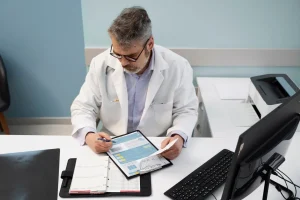
POS 11 in Medical Billing: Unique Guide
- April 16, 2025
As a medical billing professional at MedBill Florida, I’ve seen firsthand how a simple three-digit code can make or break a claim’s success. Place of Service (POS) codes might seem like a minor detail in the grand scheme of medical billing, but they play a crucial role in determining reimbursement rates and ensuring claims are processed correctly.
In my years working with healthcare providers across Florida, POS in medical billing has consistently been one of the most misunderstood yet critical elements of successful claims processing. Specifically, POS 11 in medical billing represents one of the most frequently used codes that every biller must thoroughly understand.
Table of Contents
What is POS in Medical Billing?
POS in medical billing refers to the two-digit codes that indicate where a healthcare service was provided to a patient. These codes are critical because they tell insurance companies and other payers exactly where the patient received care, which directly impacts reimbursement rates and coverage decisions.
True or false? POS codes tell the insurance company where the services were provided.
This is absolutely TRUE. In fact, it’s the primary purpose of POS codes in the billing process.
At MedBill Florida, we’ve found that many of our new clients come to us after experiencing claim denials due to incorrect POS in medical billing coding. Insurance companies are increasingly scrutinizing these codes to ensure they match the documented service location before processing payments.
Related Guide: POS 21 in Medical Billing
Key Facts About POS Codes:
- Maintained and updated by the Centers for Medicare & Medicaid Services (CMS)
- Currently includes over 50 different location designations
- Required on all professional claims (CMS-1500/837P)
- Directly affects reimbursement rates
- Must match documentation in the patient record
The importance of accurate POS in medical billing cannot be overstated. When we implement precision coding practices for our clients at MedBill Florida, we typically see a 15-20% reduction in location-related claim denials within the first billing cycle.
Understanding Place of Service 11: The Foundation of Office-Based Billing
What is Place of Service 11?
Place of service 11 is the designated code for services provided in a non-hospital physician’s office. This includes private practices, clinic settings, and other locations where physicians or other qualified healthcare professionals routinely provide outpatient services.
In my experience at MedBill Florida, place of service 11 accounts for approximately 60-70% of all outpatient claims for most primary care and specialist providers. It’s essentially the default code for office-based care and represents the most common setting where patients receive non-emergency medical services.
Place of Service 11 Description in Detail
The official place of service 11 description according to CMS is:
“Location, other than a hospital, skilled nursing facility (SNF), military treatment facility, community health center, State or local public health clinic, or intermediate care facility (ICF), where the health professional routinely provides health examinations, diagnosis, and treatment of illness or injury on an ambulatory basis.”
This place of service 11 description encompasses a wide range of healthcare settings, making it one of the most frequently used POS codes in medical billing. At MedBill Florida, we train our specialists to recognize the nuances of when this code applies versus when another POS might be more appropria
Common Settings Where POS 11 Applies
| Setting Type | Qualifies for POS 11? | Notes |
|---|---|---|
| Private physician office | Yes | Most common application |
| Medical clinic | Yes | When not hospital-owned |
| Urgent care center | Yes | If not hospital-based |
| Outpatient care center | Yes | If physician-owned |
| Hospital outpatient dept. | No | Requires POS 19 or 22 |
| Patient’s home | No | Requires POS 12 |
| Ambulatory surgical center | No | Requires POS 24 |
Understanding what is place of service 11 and applying it correctly is essential for office-based care billing success. At MedBill Florida, we’ve developed specialized training modules to help our billers distinguish between similar settings that require different POS codes.
Related Guide: In-Depth Guide to POS 22 in Medical Billing
The Critical Importance of POS 11 in Medical Billing
When it comes to POS in medical billing, code 11 represents the foundation of office-based care revenue. Using this code correctly affects:
- Reimbursement rates: Services performed in a physician’s office (POS 11) often have different payment rates than those same services performed in hospital outpatient departments or ambulatory surgical centers.
- Coverage determinations: Some services are only covered when performed in certain settings, making the correct place of service 11 in medical billing critical to payment.
- Compliance: Incorrect POS coding can trigger audits and potentially lead to allegations of fraud or abuse if patterns of miscoding are detected.
In our experience at MedBill Florida, practices that implement rigorous place of service 11 verification protocols experience up to 25% fewer claim rejections related to site-of-service discrepancies.
Real-World Impact of Correct POS 11 Coding
Let me share a quick case study from our work at MedBill Florida:
A dermatology practice we worked with was consistently using POS 11 for all their procedures, including those performed in their ambulatory surgical center. After implementing proper POS in medical billing protocols, distinguishing between their office procedures (POS 11) and those performed in their surgical suite (POS 24), their average reimbursement increased by 18% for surgical procedures. This simple correction represented over $120,000 in additional annual revenue.
What is Place of Service Code 11's Relationship to Other Codes?
Understanding what is place of service code 11 in relation to other similar codes helps prevent costly billing errors. Here’s how POS 11 compares to frequently confused alternatives:
POS 11 vs. POS 19/22 (Hospital Settings)
One of the most common errors I see in POS in medical billing is confusion between:
- Place of service 11 (Physician Office)
- POS 19 (Off-Campus Outpatient Hospital)
- POS 22 (On-Campus Outpatient Hospital)
This distinction matters significantly because hospital-based services typically receive higher reimbursement rates to account for facility overhead costs. Using what is place of service code 11 incorrectly when services were actually provided in a hospital setting can trigger audits and payment recoupments.
POS 11 vs. POS 49/50 (FQHC/RHC Settings)
Another nuanced distinction involves Federally Qualified Health Centers (FQHC) and Rural Health Clinics (RHC):
- Place of service 11 is for standard physician offices
- POS 50 is specifically for FQHCs
- POS 72 is designated for RHCs
These settings have special billing rules and often receive enhanced reimbursement rates. At MedBill Florida, we’ve helped several clinics transition from incorrect use of place of service 11 in medical billing to the appropriate FQHC/RHC codes, resulting in significant revenue improvements.
Mastering POS 11 for Routine Office Procedures
When managing POS in medical billing for routine office procedures, it’s essential to maintain detailed documentation that supports the use of place of service 11. Here are some best practices we implement at MedBill Florida:
Documentation Requirements for POS 11
For successful office-based care billing using place of service 11 means thorough documentation:
- Clear indication that the service was performed in the physician’s office
- Documentation that matches the reported place of service
- Appropriate equipment and supplies for the procedure performed
- Proper supervision documentation when required
At MedBill Florida, we’ve developed a specialized checklist system for verifying place of service 11 in medical billing documentation before claim submission, which has reduced our clients’ denial rates by approximately 23%.
Common Office Procedures Correctly Billed with POS 11
Most routine office procedures appropriately use place of service code 11:
- Evaluation and Management (E/M) services
- Minor procedures (injections, biopsies, wound care)
- Diagnostic testing (EKGs, spirometry)
- Preventive services and screenings
- Immunizations and vaccinations
For these services, using the correct POS in medical billing code ensures optimal reimbursement and reduces the risk of audit triggers.
POS Meaning in Medical Billing: Beyond the Basics
The deeper POS meaning in medical billing extends beyond just identifying locations. These codes:
- Determine fee schedules: Different payment rates apply based on where services are delivered
- Impact modifier usage: Certain modifiers only apply to specific POS codes
- Affect bundling rules: Some services are bundled differently based on the setting
- Influence medical necessity determinations: Coverage for certain procedures depends on the setting
Understanding the full POS meaning in medical billing has allowed MedBill Florida to optimize our clients’ revenue cycles by ensuring each service is billed with the most appropriate and financially advantageous setting code while maintaining compliance.
How POS Codes Influence Payer Decisions
POS in medical billing directly impacts how payers process claims:
- Place of service 11 typically receives the non-facility rate (lower than hospital rates)
- Hospital settings receive separate professional and facility payments
- Some procedures are only covered in certain settings
- Prior authorization requirements may vary by location
This understanding of POS meaning in medical billing allows MedBill Florida to strategically advise providers on optimal service locations for specific procedures while maintaining appropriate documentation.
True or False? POS Codes Tell the Insurance Company Where the Services Were Provided
The statement “True or false? POS codes tell the insurance company where the services were provided” is definitively TRUE, but there’s more nuance to understand.
POS codes provide critical location information, but they also:
- Communicate the type of facility: Different facilities have different overhead costs and safety protocols
- Indicate resource availability: Some locations have more extensive equipment and staff
- Affect coding rules: Certain code combinations are only valid in specific settings
- Impact billing regulations: Different settings follow different regulatory requirements
At MedBill Florida, we emphasize that POS in medical billing is not just about geographical location but about the entire care context. This comprehensive understanding of “true or false? POS codes tell the insurance company where the services were provided” helps us optimize claims for both approval and reimbursement rates.
Place of Service 11 in Medical Billing: Implementation Challenges
Despite seeming straightforward, implementing correct place of service 11 in medical billing presents several challenges:
Challenge #1: Practice Structure Complexity
Modern medical practices often operate in multiple locations and settings:
- Main physician office (place of service 11)
- Hospital-owned satellite clinics (POS 19/22)
- ASCs (POS 24)
- Telehealth services (POS 02/10)
MedBill Florida helps practices develop clear workflows for correctly identifying what is place of service 11 versus other settings based on physical location, ownership structure, and service type.
Challenge #2: Provider Movement Between Facilities
When providers work across multiple settings, POS in medical billing becomes more complex:
Example: Dr. Johnson sees patients at her private office in the morning (place of service 11), performs surgeries at the hospital outpatient department in the afternoon (POS 22), and conducts telehealth visits in the evening (POS 02).
This provider movement requires sophisticated scheduling and billing systems to ensure accurate place of service 11 in medical billing application. MedBill Florida implements automated location verification protocols to reduce errors in these situations.
Challenge #3: Evolving Regulatory Requirements
CMS periodically updates place of service 11 description and other POS definitions. Staying current with these changes is essential for compliance. At MedBill Florida, we maintain dedicated regulatory specialists who monitor and implement these updates across all client accounts.
POS 11 Billing: Best Practices for Success
CMS periodically updates place of service 11 description and other POS definitions. Staying current with these changes is essential for compliance. At MedBill Florida, we maintain dedicated regulatory specialists who monitor and implement these updates across all client accounts.
1. Implement Location Verification Protocols
Create a systematic approach to verify and document what is place of service 11 for each encounter:
- Update scheduling systems to capture location data
- Train front desk staff to verify and record service locations
- Include location verification in pre-billing audits
- Conduct periodic site-of-service audits
2. Develop Comprehensive POS Decision Trees
At MedBill Florida, we’ve created detailed decision matrices for determining the correct POS in medical billing codes:
IF service location is physician-owned office
AND not provider-based
AND not hospital-affiliated
THEN use Place of Service 11These decision trees help billers quickly identify when to use place of service 11 means versus other location codes.
3. Conduct Regular POS Auditing
Regular audits of POS in medical billing practices help identify patterns of errors:
- Review claims with high denial rates
- Analyze POS distribution patterns
- Compare documented locations to billed POS codes
- Verify consistency between scheduling and billing systems
MedBill Florida typically uncovers a 5-8% POS error rate during initial audits of new clients, with place of service 11 description misapplication being the most common issue.
Medical Claim Accuracy: The POS 11 Connection
Achieving medical claim accuracy requires precise use of place of service 11 in medical billing and other location codes. Here’s how MedBill Florida ensures accuracy:
Documentation Alignment
We verify that clinical documentation supports the reported POS in medical billing by confirming:
- Location references in progress notes match the POS code
- Equipment and resources mentioned are consistent with the setting
- Provider signatures and attestations reference the correct location
- Time stamps align with provider schedules
Consistent Application Across Claim Elements
Medical claim accuracy depends on consistency between all claim elements:
- Service codes appropriate for the reported setting
- Modifiers that align with the POS code
- Charge amounts consistent with the location’s fee schedule
- NPI numbers that match the service location
At MedBill Florida, our comprehensive claim review process has increased first-pass approval rates by 27% by ensuring all elements align with the correct place of service 11 or alternative POS codes.
Billing Error Prevention: POS 11 Focus Areas
Preventing billing error prevention related to place of service 11 requires attention to these common problem areas:
Hospital-Affiliated Services
A frequent source of errors involves hospital-affiliated services incorrectly billed with place of service 11:
❌ Incorrect: Billing hospital-based department services with POS 11 ✅ Correct: Using POS 19 or 22 for hospital outpatient services
This distinction is crucial for POS in medical billing accuracy and reimbursement, as MedBill Florida has helped numerous practices correct this specific issue.
Telehealth Services
With the growth of virtual care, telehealth POS coding has become a common error point:
❌ Incorrect: Using place of service 11 for telehealth services ✅ Correct: Using POS 02 (Telehealth) or 10 (Patient’s Home via Telehealth)
MedBill Florida has developed specialized telehealth billing protocols to ensure proper POS in medical billing application for virtual services.
Multi-Location Practices
Practices with multiple office locations require careful attention to place of service 11 in medical billing:
❌ Incorrect: Using a generic POS 11 for all locations ✅ Correct: Associating specific address information with each location
Though all office locations use place of service 11, accurate address reporting is essential for proper enrollment and credentialing. MedBill Florida implements location-specific identifiers to maintain this distinction.
Healthcare Revenue Management: Optimizing POS 11 Usage
Effective healthcare revenue management requires strategic application of POS in medical billing principles. At MedBill Florida, we’ve identified several optimization opportunities:
Service Site Selection Strategies
For practices with multiple facility options, strategic service site selection can optimize reimbursement:
- Some procedures receive higher reimbursement in ASCs than in office settings
- Certain services are better reimbursed under place of service 11 than hospital settings
- Some complex services may require specialized facilities for safety and quality
- Understanding POS 11 in medical billing guidelines helps determine which services are most appropriate for office settings
MedBill Florida analyzes payer contracts and fee schedules to help practices make informed decisions about optimal service locations, balancing office-based care with other settings for maximum reimbursement.
POS-Based Fee Schedule Optimization
Different payers reimburse at different rates based on POS in medical billing codes:
| Procedure | POS 11 Rate | POS 22 Rate | POS 24 Rate | Optimal Setting |
|---|---|---|---|---|
| Minor skin biopsy | $150 | $105 | $125 | Office (POS 11) |
| Colonoscopy | $425 | $380 | $550 | ASC (POS 24) |
| Complex wound care | $275 | $350 | $310 | Hospital (POS 22) |
MedBill Florida performs this analysis for clients to maximize healthcare revenue management through optimal service location planning.
Reimbursement Optimization Through POS Analysis
Understanding what is place of service 11 versus other settings has allowed MedBill Florida to identify patterns where our clients can optimize service locations for both patient convenience and practice revenue.
CMS Billing Code Updates: Impact on POS 11
As a CMS billing code, place of service designations periodically undergo updates and revisions. Recent changes affecting place of service 11 include:
Telehealth Expansions
During the pandemic, CMS temporarily allowed certain services traditionally requiring place of service 11 to be provided via telehealth. Many of these flexibilities have been extended, creating new opportunities for practices to serve patients remotely while maintaining appropriate revenue.
New POS Code Introductions
CMS has introduced several new POS codes in recent years that may impact when place of service 11 should be used:
- POS 19: Off-Campus Outpatient Hospital
- POS 17: Walk-in Retail Health Clinic
- POS 15: Mobile Unit
These additions create more specific options that previously might have defaulted to place of service 11 in some billing scenarios. At MedBill Florida, we ensure our coding specialists remain updated on these CMS billing code changes.
Non-Hospital Services: The Heart of POS 11
Place of service 11 primarily identifies non-hospital services provided in physician offices. Understanding this distinction helps clarify when to use this code versus hospital-based alternatives.
Key Characteristics of Non-Hospital Services
Services appropriately billed with place of service 11 typically:
- Take place in physician-owned or leased space
- Use equipment owned by the practice
- Are supervised by the treating physician
- Do not involve facility fees
- Follow office-based protocols rather than hospital regulations
MedBill Florida helps practices clearly delineate between non-hospital services and hospital-based care to ensure proper place of service 11 in medical billing application.
Common Non-Hospital Services Billed with POS 11
The most frequent non-hospital services billed with place of service 11 include:
- Preventive care and wellness visits
- Chronic disease management
- Minor procedures and treatments
- Diagnostic testing
- Immunizations and injections
- Counseling and education
Understanding and correctly coding these non-hospital services with the appropriate place of service 11 designation optimizes revenue while maintaining compliance.
Affordable Outpatient Services: The POS 11 Advantage
One significant benefit of place of service 11 settings is that they typically deliver more affordable outpatient services compared to hospital-based alternatives. At MedBill Florida, we’ve observed that identical procedures can cost 30-50% less when performed in physician offices versus hospital outpatient departments.
Cost Comparison: POS 11 vs. Hospital Settings
| Procedure | POS 11 (Office) Cost | POS 22 (Hospital) Cost | Patient Savings |
|---|---|---|---|
| Joint injection | $285 | $475 | $190 (40%) |
| EGD | $1,250 | $2,100 | $850 (40%) |
| Echocardiogram | $350 | $625 | $275 (44%) |
| Skin biopsy | $225 | $375 | $150 (40%) |
This cost differential makes office-based care an important component of healthcare cost containment strategies. MedBill Florida helps practices communicate these cost advantages to patients and referring providers.
Insurance Coverage for Office-Based Care
Most insurance plans provide better coverage for affordable outpatient services performed in place of service 11 settings:
- Lower copayments for office procedures
- Reduced coinsurance percentages
- Services may count toward office visit benefits rather than hospital benefits
Understanding these coverage distinctions helps practices effectively communicate with patients about their financial responsibility for services based on location.
Medical Coding Compliance: POS 11 Requirements
Maintaining medical coding compliance with place of service 11 requires adhering to specific documentation and coding standards:
Key Compliance Requirements for POS 11
- Complete Documentation: Notes must clearly indicate the service was performed in the physician’s office
- Setting Appropriateness: The procedure must be clinically appropriate for an office setting
- Equipment Verification: Documentation should reflect the use of physician-owned equipment
- Supervision Documentation: Proper physician supervision must be documented
- Modifier Accuracy: Any location-specific modifiers must be correctly applied
- Consistent Application: POS 11 in medical billing should be consistently applied across all related services performed in the office setting
MedBill Florida’s compliance team conducts regular audits to ensure all place of service 11 in medical billing meets these requirements, protecting our clients from audit risks.
Common Compliance Risks with POS 11
Some frequent medical coding compliance risks related to POS in medical billing include:
- Incorrect use of place of service 11 for hospital-based services
- Failure to use POS 19/22 for provider-based departments
- Inconsistent POS coding across related services
- Missing or incomplete documentation of service location
At MedBill Florida, our comprehensive compliance program has reduced these risks by implementing systematic verification procedures
MedBill Florida's Approach to POS in Medical Billing
At MedBill Florida, we’ve developed a comprehensive approach to POS in medical billing that maximizes accuracy and reimbursement:
Our POS Optimization Process
- Practice Assessment: We analyze your practice structure and service locations
- Setting Documentation: We implement protocols for consistent location documentation
- POS Verification: We create automated checks to verify POS code accuracy
- Reimbursement Analysis: We compare payment rates across different settings
- Strategic Planning: We help optimize service locations for maximum reimbursement
- Ongoing Monitoring: We continuously track POS-related denials and adjustments
This systematic approach has helped our clients achieve a 97% first-pass acceptance rate for claims involving place of service 11 in medical billing.
Real-World Results
Our clients typically see:
- 15-20% reduction in location-related claim denials
- 8-12% improvement in reimbursement rates through strategic service location
- 30% faster resolution of POS-related claim issues
- Significant reduction in audit risk
Conclusion: Mastering POS 11 for Billing Success
Understanding what is place of service 11 and applying it correctly is essential for medical billing success in today’s complex healthcare environment. As we’ve explored throughout this guide, POS in medical billing affects everything from reimbursement rates to compliance risk. Properly implementing POS 11 in medical billing can make a significant difference in claim approval rates and practice revenue.
At MedBill Florida, we’ve seen firsthand how mastering place of service 11 in medical billing can transform a practice’s revenue cycle performance. The difference between correct and incorrect POS coding can mean thousands of dollars in additional revenue and significantly reduced administrative burden.
Remember these key takeaways:
- Place of service 11 specifically designates physician office settings
- POS codes directly impact reimbursement rates and coverage determinations
- Documentation must support the reported POS code
- Strategic service location planning can optimize reimbursement
- Regular auditing and monitoring are essential for compliance
How MedBill Florida Can Help
If you’re struggling with POS in medical billing or want to optimize your practice’s approach to location coding, MedBill Florida offers specialized solutions:
- Comprehensive POS audit and optimization
- Staff training on location documentation and coding
- Implementation of POS verification protocols
- Strategic service location planning
- Ongoing monitoring and performance improvement
Contact us today to learn how our expertise in place of service 11 and other location codes can improve your practice’s financial performance and compliance posture.
Grow Your Practice with Us!
Frequently Asked Questions
What does POS 11 mean in medical billing and when should it be used?
POS 11 indicates that services were provided in a physician’s office setting. This code should be used when healthcare services are delivered in a location where a healthcare professional routinely provides examinations, diagnoses, and treatment of illness or injury on an ambulatory basis. This includes private practices, clinics, and other non-hospital outpatient settings owned by physicians. POS 11 is the most commonly used place of service code for routine office visits and procedures performed in a doctor’s office.
True or false? POS codes tell the insurance company where the services were provided.
True! POS codes are specifically designed to inform insurance companies and other payers about the exact location where healthcare services were provided to a patient. This information is critical because reimbursement rates vary significantly based on the setting. Insurance companies use POS codes to determine appropriate payment amounts, apply correct fee schedules, and ensure services were delivered in appropriate settings according to their coverage policies.
What's the difference between POS 11 and hospital-based POS codes like 19 and 22?
The main difference lies in facility ownership and associated costs:
- POS 11 (Physician Office): Services provided in physician-owned or leased spaces where the practice bears all overhead costs. Typically receives non-facility payment rates.
- POS 19 (Off-Campus Outpatient Hospital): Services provided in hospital-owned facilities that are not physically connected to the main hospital campus.
- POS 22 (On-Campus Outpatient Hospital): Services provided in hospital-owned facilities on the main hospital campus.
Hospital-based settings (POS 19/22) typically receive higher reimbursement rates because they include both facility and professional components. Using the wrong code can result in significant payment differences and potential compliance issues.
How do POS codes affect patient out-of-pocket costs?
POS codes directly impact what patients pay for services. Most insurance plans structure benefits differently based on where services are provided:
- Services in physician offices (POS 11) typically have lower copayments and coinsurance rates
- Hospital-based services (POS 19/22) often require higher patient cost-sharing
- Some specialized settings may have specific benefit structures
At MedBill Florida, we’ve seen cases where identical procedures cost patients 30-50% less when performed in a physician’s office versus a hospital outpatient department, making proper POS coding essential for patient financial counseling.
What are the most common POS 11 billing errors and how can they be prevented?
The most frequent POS 11 billing errors include:
- Incorrect facility designation: Using POS 11 for hospital-owned departments or provider-based clinics
- Telehealth miscoding: Applying POS 11 to telehealth services instead of the appropriate telehealth codes
- Documentation mismatches: Billing POS 11 without supporting documentation of the office setting
- Inconsistent coding: Using different POS codes for related services provided in the same location
These errors can be prevented through:
- Comprehensive staff training on POS applications
- Implementing verification protocols in your billing process
- Regular auditing of POS code usage
- Working with an experienced medical billing partner like MedBill Florida that specializes in coding accuracy and compliance
For personalized assistance with your POS coding challenges, contact MedBill Florida.

Dr. Emily R. Collins
- Follow Us
Free Up Your Staff
Let our experts handle scheduling, calls, documentation, and paperwork 24/7



